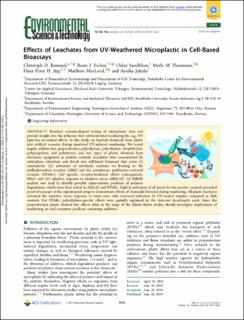Effects of Leachates from UV-Weathered Microplastic in Cell-Based Bioassays
Rummel, Christophe Daniel; Escher, Beate I.; Sandblom, Oskar; Plassmann, Merle; Arp, Hans Peter; MacLeod, Matthew; Jahnke, Annika
Peer reviewed, Journal article
Published version
Permanent lenke
https://hdl.handle.net/11250/2647498Utgivelsesdato
2019Metadata
Vis full innførselSamlinger
- NGI articles [1024]
Originalversjon
Environmental Science and Technology. 2019, 53 (15), 9214-9223. 10.1021/acs.est.9b02400Sammendrag
Standard ecotoxicological testing of microplastic does not provide insight into the influence that environmental weathering by, e.g., UV light has on related effects. In this study, we leached chemicals from plastic into artificial sea water during simulated UV-induced weathering. We tested largely additive-free pre-production polyethylene, polyethylene terephthalate, polypropylene and polystyrene and two types of plastic obtained from electronic equipment as positive controls. Leachates were concentrated by solid-phase extraction and dosed into cell-based bioassays that cover i) cytotoxicity; ii) activation of metabolic enzymes via binding to the arylhydrocarbon receptor (AhR) and the peroxisome proliferator-activated receptor (PPARγ); iii) specific, receptor-mediated effects (estrogenicity, ER); and iv) adaptive response to oxidative stress (AREc32). LC-HRMS analysis was used to identify possible chain-scission products of polymer degradation, which were then tested in AREc32 and PPARγ. Explicit activation of all assays by the positive controls provided proof-of-concept of the experimental setup to demonstrate effects of chemicals liberated during weathering. All plastic leachates activated the oxidative stress response, in most cases with increased induction by UV-treated samples compared to dark controls. For PPARγ, polyethylene-specific effects were partially explained by the detected dicarboxylic acids. Since the pre-production plastic showed low effects often in the range of the blanks future studies should investigate implications of weathering on end consumer products containing additives.
